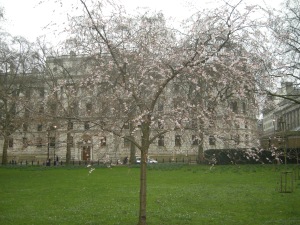Position: Full sun to partial shade
Soil: Moist, well drained
Flowering period: Autumn to spring
Eventual Height: 8m
Eventual Spread: 8m
Hardiness: 5a, 5b, 6a, 6b, 7a, 7b, 8a, 8b, 9a, 9b
Family: Rosaceae
Prunus subhirtella ‘Autumnalis’ is a deciduous tree with a spreading habit. During the summer it has ovate, taper pointed dark green leaves which yellow in autumn. It bears it bears semi-double, pink tinged white flowers in mild periods between autumn to spring. They present in clusters of two to five and are sometimes followed by cherry like, ovoid, red to black fruit.
Prunus subhirtella ‘Autumnalis’, commonly known as Spring Cherry, Higan cherry, or Rosebud Cherry, is native to Japan. The species is believed to be cultivated with no records of it in the wild.
The etymological root of the binomial name Prunus is from the classical name of the plum tree. Subhirtella is derived from the Latin hirtus ‘hairy’ referring to the leaves and young wood. Autumnalis refers to autumn flowering.
Prunus subhirtella ‘Autumnalis’ is useful to the landscape architect for its autumn colour and winter flowers. It is best placed as a specimen tree and allowed to produce its own natural architectural form.
Ecologically, Prunus subhirtella ‘Autumnalis’ is attractive to bees.
The Royal Horticultural Society have given Prunus subhirtella ‘Autumnalis’ their prestigious Award of Garden Merit.
Prunus subhirtella ‘Autumnalis’ prefers moist, fertile, well-drained soils. It tolerates most pH of soil.
Prunus subhirtella ‘Autumnalis’ requires little maintenance. Under no circumstances should it be lightly pruned. If it requires pruning due to damage the whole branch should be removed. Pruning should be carried out after flowering, from April to July to minimise the risk of Silver leaf infection.





